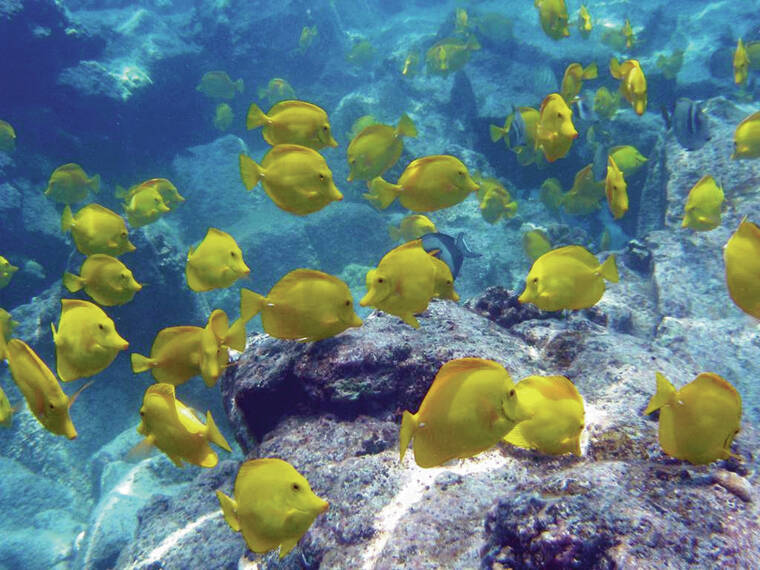The latest proposal to bring commercial aquarium fishing back to
Hawaii has failed after the state Board of Land and Natural Resources refused to accept an environmental study detailing the impacts of the industry on Oahu.
After about four hours of testimony and questioning, the BLNR voted Friday to deny a final environmental impact statement supporting the issua Opens in a new tabnce of permits to 15 commercial aquarium collectors so they could catch fish in Oahu waters.
The seven-member board voted 6-0 to deny the FEIS, with board member Doreen Canto abstaining from the vote. Board members maintained that in regard to analysis of aquarium fishing’s impact on species as well as satisfactory levels of outreach to cultural experts and the public at large, the study fell short.
“I would have a hard time making a decision on permits based on this” environmental impact statement, BLNR Chairwoman Suzanne Case said during the meeting. “What is the impact to each of those fish for that level of take? I just don’t see that analysis there.”
The Pet Industry Joint Advisory Council prepared the review, which provided a white list of 31 finfish species and four invertebrate species from which the 15 collectors would have been able to take. It would have allowed the collectors to take more than 92,000 individual fish per year and more than 200,000 invertebrates.
But the FEIS contained more raw data than analysis on the economic and environmental impacts of aquarium fishing, Case said.
“What we’re trying to do is figure out how many fish should there be out there, and therefore how much you can take away,” she said. “I’m just not convinced yet that we have that information available to make that analysis.”
She also found it problematic that the FEIS proposed quotas for three fish species and the four invertebrate species — zebra and Halloween hermit crabs, feather duster worms and cleaner shrimp — despite missing data about their local population sizes.
PIJAC publicized a draft review in May 2020 for public comment and attempted to address those comments in the final review. But opponents of the FEIS said the changes made — including the introduction of new target species and annual quotas for each of them — are significant enough to require additional community and cultural vetting.
The lack of public engagement was a sticking point for BLNR member Kaiwi Yoon.
“I asked about the discrepancy between the previous documents and the documents today, and in my mind there’s no real good answer,” Yoon said, referring to the differences between the draft and final EIS. “We need to give the community time to respond to any kind of change, and while some might not think it’s a substantial change, I think it is.”
The BLNR will now draft a letter for PIJAC detailing the reasons why it rejected the FEIS, which will serve
as a guide for the national council if it wants to submit another environmental
review.
Friday’s vote was a blow to aquarium fishers and their supporters, who want to revive aquarium fishing in Hawaii, where it is currently banned. The ban was established in 2017 after a Hawaii Supreme Court ruling, and further rulings — the latest being a Circuit Court order in January — closed loopholes that had allowed fishers to continue collecting.
While the vote on its face was a thorough rebuff of aquarium fishing in Hawaii, the issue has continued to be a difficult topic for the BLNR.
The six members who were present in a June meeting split their vote to accept a revised FEIS, also prepared by PIJAC, in support of aquarium fishing in the West Hawaii Regional Fishery Management Area on the west coast of Hawaii island.
Board member Vernon Char, although voting to deny the FEIS on Friday, echoed concerns that creating an adequate environmental review for aquarium fishing is a frustratingly difficult process. He noted that the changes made in the FEIS would actually restrict aquarium fish collection, but even then it was problematic.
“I’m troubled by the whole process,” Char said. “If the community says you should tighten it up and they tighten it up, they get dinged for trying to take the public comment … and improve the situation. And now they’re told, ‘You’ve got to go to ground zero again.’”
Board member Chris Yuen, who also voted against the FEIS but was more sympathetic toward the aquarium fishers, commended the changes that were made to address the issues in the draft review and noted that the aquarium fishing industry has adjusted in response to those issues.
Yuen voted to approve the West Hawaii review in June in part because it contained large swaths of protected coastline, but said it isn’t the case on Oahu. “Looking at what we have on marine protected resources on Oahu, it’s just pathetic,” Yuen said.

